1.8: Shang State and Society
- Page ID
- 135153
Shang society and state were both aristocratic. Society refers to the organized collectivity of all people in a certain place-time; in an aristocratic society almost all people remain in the social stratum, or rank, into which they are born. There is little social mobility up or down the social scale. People’s proper roles and life possibilities are largely determined by their family’s rank, in combination with their gender and rank within the family and other factors. The upper ranks of the social hierarchy, the “nobility” (confusingly also called “the aristocracy”) openly say, write, and believe that they are intrinsically, essentially better than others because of the families into which they were born. In particular, noblemen across the world insist on their own superiority not only to poor, low-ranking people (whom they hardly considered worth talking about) but also, and especially, to wealthy, low-ranking people. Wealth may attend rank in an aristocratic society, but in itself it does not grant high social standing. (Wealth – the ownership of the means of production – determines class, not rank, and class-based societies appear later in East Asian history than rank-based ones, as we shall see.) People of lower ranks may or may not have agreed about who was better; but few sources tell us what they thought.
The state is the imagined entity that holds the right to control people and territory. It does that through changing government institutions that manage society and its resources, and in an aristocratic state political power exercised through government is inherited by families. Got it?
The aristocratic society and state of Shang was a monarchy. It centered on the king (wang 王). The king had a retinue of hundreds of people, the nobility or aristocracy, collectively called the zhong 衆. (This word changed its meaning over time.) The nobility comprised clans (patrilineal descent groups) called zu 族. They were closely linked to the king. Oracle bone inscriptions record that the king reported to his ancestors on the noble clans’ activities, asked whether they would be lost in battle, and offered sacrifices to assure that his royal ancestors would protect them. The nobility made up his court and his support, often travelling with him.
As well as the king’s own clan, there were those of his uncles and cousins; those that provided the king with consorts (royal wives); clans of diviners; and clans who managed the Shang farms and mines and other resources. Each noble clan had its special skills – mining,
farming, weaving, making pottery, jewelry, rope, fences, etc. – in which its children were trained, to provide those skills to the kings, generation after generation. Archaeologists have found people of the same surname, indicating a craft, buried in cemeteries together. Although only royal oracle bones were inscribed with texts, other people both at Anyang and quite far away, both of the elite and ordinary people, continued to practice bone divination.17

Socially ranked beneath the noble clans, and with no special ties to the king and no political power, were another kind of people called the ren 人 (ordinary people). They did the hard work of all kinds under the direction of the clans, and their lives were fairly grim. They might live on a clan estate, or in an isolated village amidst the forest. They were not slaves, because they were called up for work, usually in winter, in groups of a thousand or three thousand, and then sent back home to their farming, which relied on Neolithic-style tools of wood with blades of stone, bone, or clam shells. A few bronze spades and pickaxes have been found, but the king did not waste bronze on farmers, nor ask his ancestors about their welfare in the oracle bones.
Let’s map these three social groups – the royal family, the other aristocratic clans, and the ordinary people – onto the landscape. Anyang, the king’s capital, was surrounded by fields cultivated from spring to autumn to feed the royal family. Not far away, the noble clans had their own estates, the fields cultivated by their people. Beyond and between them was a hinterland of more isolated settlements under lesser Shang chiefs, with fields around them. All the dwellings and fields were set in lots of forest. Beyond the core area centered on Anyang were the settlements of the unrelated chiefs with whom Shang alternately allied and fought.


